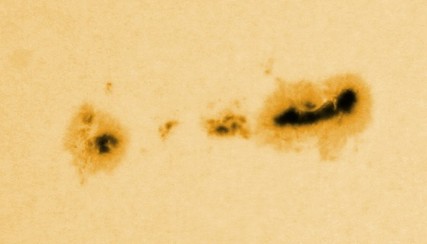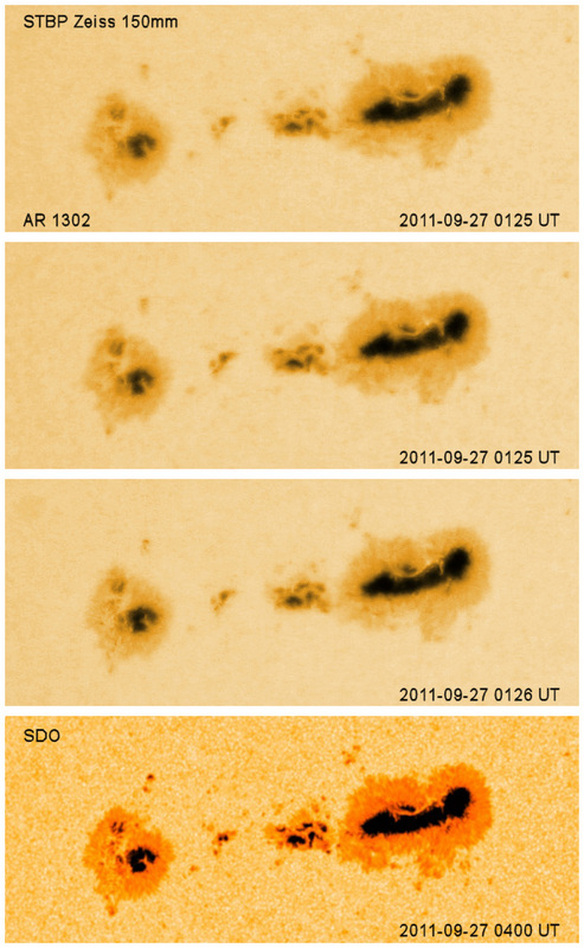The Sun
It's up there every day, although if you live in the west of Scotland this might so evident. For all of its normally-glaring presence though, it is an unfamiliar object to most people. Unless you have the equipment and knowledge to observe it properly, or have the good fortune to see it low in the sky near sunset or sunrise, dimmed by cloud, mist or haze, you will likely be a stranger to its appearance on a daily basis. But then again, there is the internet, and such sites as Spaceweather.com, with its daily NASA image of our source of heat and light. It's been around for 5 billion years, and it will be another 5 billion before it runs out of hydrogen puff, and has to rearrange itself to start burning helium, becoming a red giant in the process. Still plenty of time to plant those tomatoes, then.
The Sun goes through a cycle of activity roughly 11 years long (although some sources claim it is a 22-year cycle). During that time, sunspot numbers rise and fall, the outer atmosphere - the corona - displays marked changes, and we are assaulted with varying levels of emission, including some pretty energetic and disturbing flares. Just now (late 2011) the Sun is coming out of an extended period of inactivity, and numerous sunspot groups are making their way across the disk. Some of the current activity has given rise to spectacular auroral displays, around both north and south poles; sadly, Brisbanites do not get to enjoy the fun.
Seen up close, the Sun is an amazing sight. Surface granulation - in reality the boiling surface of the plasma ball - sunspots and faculae all provide a changing display that cannot fail to be interesting. Dedicated solar telescopes can show the Sun in other than normal wavelengths, such as hydrogen-alpha or ultra-violet. It is when you look at the Sun in other than 'white' light that you come to appreciate its power and phenomenal energy output. Unfortunately, the Brisbane Planetarium Zeiss refractor is not a dedicated solar 'scope, so I cannot at present observe in other than white light. Even then, there is usually so much heat in and around the dome, and in the air, that the image is ruined with turbulence from rising heat. Occasionally, there is a moment of stability on days when the outside temperature hasn't yet reached an uncomfortable level, and I would hope to catch the Sun in those more moderate moments.
The Sun goes through a cycle of activity roughly 11 years long (although some sources claim it is a 22-year cycle). During that time, sunspot numbers rise and fall, the outer atmosphere - the corona - displays marked changes, and we are assaulted with varying levels of emission, including some pretty energetic and disturbing flares. Just now (late 2011) the Sun is coming out of an extended period of inactivity, and numerous sunspot groups are making their way across the disk. Some of the current activity has given rise to spectacular auroral displays, around both north and south poles; sadly, Brisbanites do not get to enjoy the fun.
Seen up close, the Sun is an amazing sight. Surface granulation - in reality the boiling surface of the plasma ball - sunspots and faculae all provide a changing display that cannot fail to be interesting. Dedicated solar telescopes can show the Sun in other than normal wavelengths, such as hydrogen-alpha or ultra-violet. It is when you look at the Sun in other than 'white' light that you come to appreciate its power and phenomenal energy output. Unfortunately, the Brisbane Planetarium Zeiss refractor is not a dedicated solar 'scope, so I cannot at present observe in other than white light. Even then, there is usually so much heat in and around the dome, and in the air, that the image is ruined with turbulence from rising heat. Occasionally, there is a moment of stability on days when the outside temperature hasn't yet reached an uncomfortable level, and I would hope to catch the Sun in those more moderate moments.
Zeiss 150mm refractor v NASA's SDO satellite
A comparison of prime focus photography on the Zeiss with the incredible image quality of the Solar Dynamics Observatory satellite. There ought to be no comparison, given the location of the Zeiss, but these images are not a million miles removed from what's visible in the SDO image of just about 90 minutes later.
Zeiss images

This GIF animation is a combination of the 3 best exposures - 2 of 1/2000 second, and one of 1/1500; it shows very clearly the turbulence and image distortion. The green channel only has been selected, the tones adjusted, and the image colorized to give an artificial but pseudo-natural result.
Click image for animation.
Click image for animation.
Zeiss v SDO

There is no texture visible in the Zeiss images that can reasonably be identified as solar granulation, but some of the fine umbral detail seen in the SDO image can also be made out in some of the Zeiss ones.
For a sense of scale, these images span around 230,000 km - around 19 times the diameter of the Earth.
See Spaceweather.com for daily images from SDO.
For a sense of scale, these images span around 230,000 km - around 19 times the diameter of the Earth.
See Spaceweather.com for daily images from SDO.
